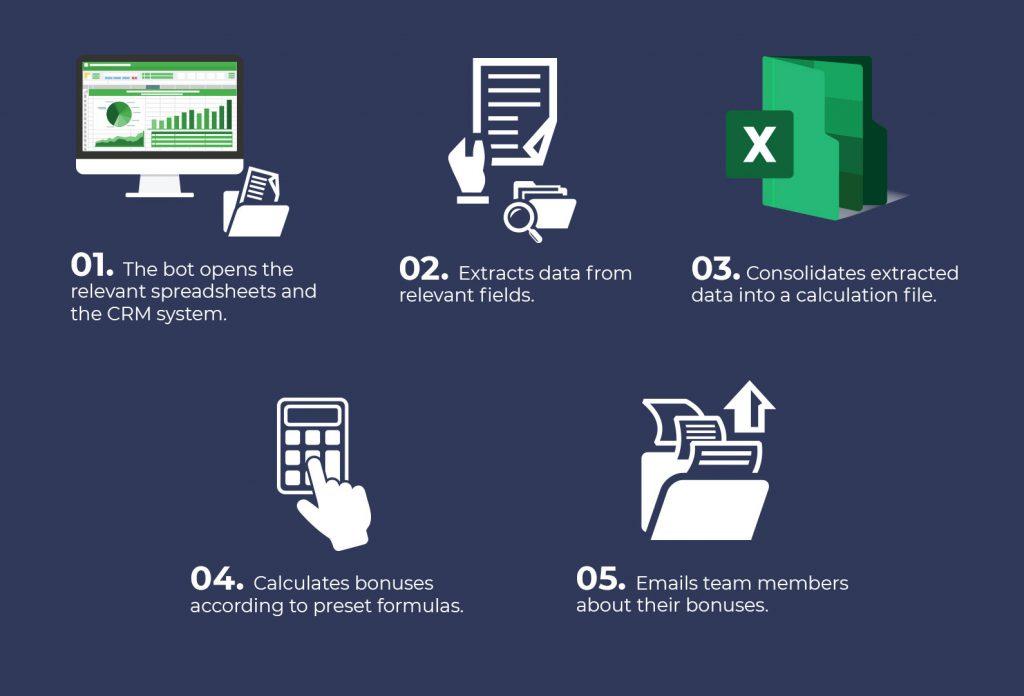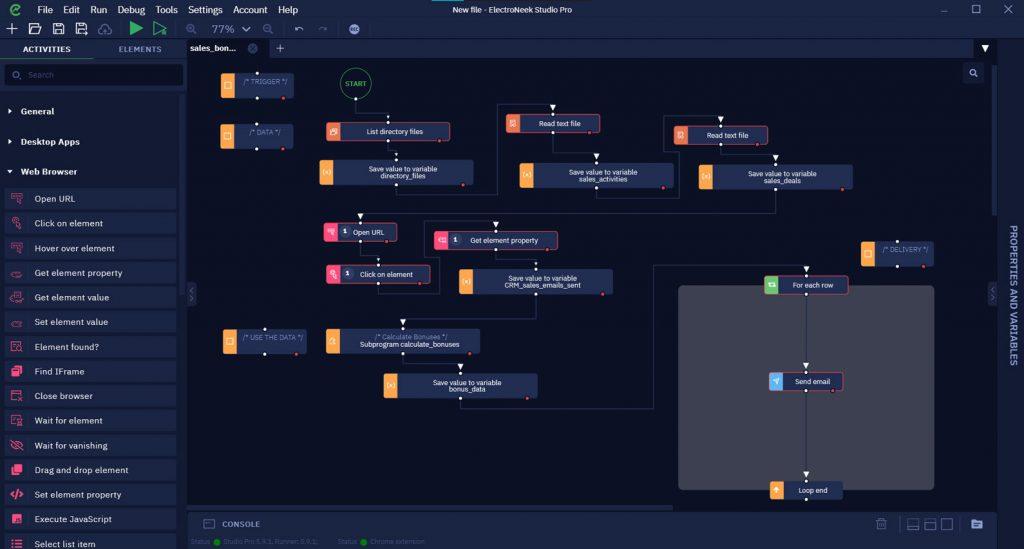In the previous article, we have discussed what robotic process automation (RPA) is. Now, let’s take a look at what bots in RPA are, how they work, and how automation can help your company boost its productivity.
RPA bots uncovered
RPA bots are software robots. Since they are programmable algorithms, bots in RPA don’t have any futuristic physical form as industrial robots: they perform tasks only in a digital environment.
The goal of bots in RPA is to automate repetitive mundane tasks and execute work processes that are normally performed by regular human employees. Therefore, they are often called “digital workers” or a “digital workforce.” These digital workers can work independently as well as under human supervision (more about automation types later in the article).
Now, let’s imagine Bob, who is a Head of Sales. The end of the month is a hot time for Bob because he needs to calculate monthly bonuses for his team. To collect information on deals and activities for each sales rep, he has to switch between a CRM system and multiple Excel spreadsheets. There are 15 people in his team, so the process can take his whole workday. However, after implementing an automation bot, it takes just a few minutes:

Since it’s the RPA bot that takes care of the bonus calculations, Bob now has an extra eight hours to spend on more meaningful tasks, such as negotiations with important prospects or mentoring his team.
How do bots work and what can they do?
There are different types of processes RPA bots can handle, from simple to quite complex. Typically, companies implement RPA for automating linear rule-based activities, such as conducting surveys, filling in forms, invoicing, etc. Regardless of the exact function of each bot, their workflow includes four main steps:
- Triggering
- Input data acquisition
- Input data transformation
- Output delivery
Let’s have a closer look at each step.
1. Triggering
A trigger is an event, condition, or a set of them; simply put, it’s something that kicks off an automated task. What will launch the bot? How is it going to run? Here are some of the most common trigger types:
- Schedule trigger. You can launch a bot on certain days or at a certain time. You can also schedule repetitive launches, say, execute a task every three days or once a week. For example, you can schedule a bot to prepare an executive report with analytics data at 10 a.m. every Friday.
- Email trigger. You can make a bot monitor your inbox for emails that meet certain criteria, for example, if there are any attachments. Once the requirement is met, the bot kicks in.
- File trigger. A bot launches when there are certain files or folders available, for example, if new files are added or their amount reaches a certain number.
- Window trigger. This launches a bot when a certain window opens or closes. It can be useful to set a trigger for an error message pop-up window.
- Interface trigger. A click, a keystroke, or a sequence of keys trigger a task. You can also make this trigger work only in a certain app.
- Database trigger. The task kicks off when a specific operation happens in a database, for example, if someone enters new data.
2. Input data acquisition
Before acting, a bot needs to collect certain data. It could be information from emails, spreadsheets, CRM and ERP systems, databases, etc. As a rule, modern RPA platforms enable OCR, or Optical Character Recognition. This technology recognizes text and, for example, can retrieve it from relevant fields in scanned documents to use for further processing.
3. Input data transformation
This step is the actual purpose of RPA bots. For example, it can be sorting emails, transcribing voice messages, creating an invoice by filling in the fields with data taken from a variety of other applications like CRM, and more. You’ll find plenty of ideas for automation in ElectroNeek’s Bot Library.
4. Output delivery
Once a bot executes its target action, it needs to communicate the result with stakeholders (“Here’s your task. It’s done.”). The report can be in the form of:
- An email;
- A report in PDF, XLS, or any other format;
- A generated dashboard;
- An update in a database;
- A notification in a messenger;
- and more.
Now, let’s have a look at what this sequence of steps might look like in a real-world automation workflow.
Real-life example
Let’s get back to Bob and his sales bonus calculation bot. The workflow can be easily broken into those same four steps.
- Triggering: A person manually launches the process by double-clicking the desktop icon.
- Input data acquisition: The bot collects the latest data on activities and transactions.
- Input data transformation: The bot inserts the collected data into a spreadsheet with bonus calculation formulas.
- Output delivery: The bot distributes the final bonus sums via employees’ emails.

What can’t RPA bots do?
The key distinguishing feature of RPA bots lies in their decision-making process. Their actions are based on a pre-programmed scenario, which may consist of a single condition or a set of them. That means they rely on formal logic and can’t improvise or effectively operate in changing conditions.
Another thing to keep in mind is that RPA bots don’t strive to achieve any particular high-level goal. They execute the processes that are explicitly specified in their task. The task is considered completed if the bot succeeds in executing the necessary steps. Even if there are plenty of error messages, as long as they don’t prevent the execution of the specific process, the bot will ignore them.
The important conclusion here is that a formally successful execution of a script doesn’t guarantee the expected business result.
Types of bots in RPA

There are two basic types of RPA bots: attended and unattended ones. Recently, we’ve witnessed the appearance of a new, more intelligent one. What is the purpose of these types, and which one is better? Let's find out.
Attended RPA bots
Attended automation is like a virtual assistant that helps you complete tasks. The emphasis is on “helps,” because you still need to handle the bot; now, it’s just easier for you. A good example would be a software bot in a call center that sales reps can use to look up information while they’re talking to clients. In other words, an employee can launch an attended bot to take over just a part of an activity. Once the bot has finished with its part, the employee gets control back.
Attended RPA is often referred to as a “desktop robot” because it usually sits right on your computer.
Use cases for attended RPA:
- Accelerating and streamlining employee’s daily routines
- Repetitive tasks that require real-time human-system interaction
Unattended RPA bots
If you hear something about RPA bots that are ready to work 24/7, that's exactly what unattended automation is about. In unattended automation, workflows don’t require a person to manually kick it off: a bot is self-triggered when it meets certain circumstances. For example, it can send alerts when your office printer requires maintenance or the ink needs refilling.
Unattended bots run on servers.
Use cases for unattended RPA:
- Automating back-office processes
- Automating tasks (and even job roles) that can be entirely mapped
Intelligent process automation (IPA)
Intelligent process automation is the most recent type of RPA. It employs artificial intelligence (AI) technology, enabling bots to learn, grow smarter, and get better at processing non-linear tasks and unstructured data.
A couple of examples of IPA would be image recognition or voicemail transcription, which leverages natural language processing. Another example is handling invoices. With AI, an RPA bot can not only process payment requests, but also structure the invoices, which may come in various forms from different contractors, according to a single set of rules.
Key takeaways
- RPA bots are software robots that emulate human employee actions and execute tasks in a digital environment.
- RPA bots are good at performing structured, well-mapped tasks, but usually struggle working in ever-changing conditions or with unstructured data.
- Attended bots are used as assistants that cover the most laborious and tedious part of a task. A human employee launches them manually and has all the control.
- Unattended bots serve mostly for back-office functions and don’t require human interference.
- Intelligent process automation means using RPA enhanced with AI technology.
What’s next?
In the next article, we’ll have a closer look at the benefits that robotic process automation can bring to companies, see if it’s possible to measure its positive impact, and discuss some real-world examples of RPA implementation.
Stay tuned to learn everything about RPA, and if you prefer to ask your questions personally, ElectroNeek’s RPA experts are more than happy to conduct a call tailored to your business needs.
